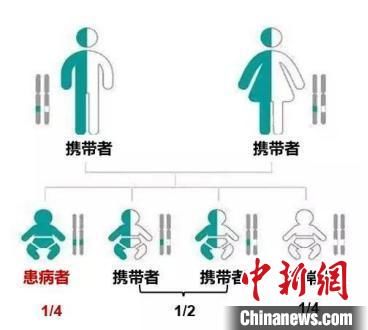
Patterns of inheritance in autosomal recessive disorders. Photo courtesy of the First Affiliated Hospital of China University of Science and Technology
China News Service, Hefei, February 27th (Reporter Zhang Qiang) “Mermaid baby” (deformed legs), “porcelain doll” (Osteogenesis imperfecta), “Moon child” (albinism)… These are poetic Behind his name is the unspeakable pain of rare disease patients.
February 28, 2022 is the 15th “International Rare Disease Day”. According to the definition of the World Health Organization, rare diseases are diseases or lesions with the number of patients between 0.65‰ and 1‰ of the total population. According to the minimum incidence rate, there are more than 10 million rare disease patients in China.
In 2021, a 2-year-old boy Xuanxuan (pseudonym) was transferred from a foreign hospital to the Pediatrics Department of the First Affiliated Hospital of China University of Science and Technology (Anhui Provincial Hospital) due to acute renal failure. After active treatment, Xuanxuan’s infection was quickly diagnosed. Control, renal function has also been significantly restored.
However, during the diagnosis and treatment, the medical staff found that Xuanxuan had obvious behavioral developmental abnormalities: he was almost 2 years old and still could not sit, could not call his mother, feeding was also very difficult, and he was always crying and scratching.
“Xuanxuan is my third son. One of the first two children died at 13 months and the other died at 10 months. Our family seems to be under a ‘curse’, child. There is always no way to grow up healthy.” Xuanxuan’s mother told the doctor that several children had backward behavioral development, and the first two children had convulsions.
“According to Xuanxuan’s mother’s description, we feel that Xuanxuan is likely to have a genetic disease.” said Yang Chunfang, deputy chief physician of the Department of Pediatrics at the First Affiliated Hospital of China University of Science and Technology.
Through genetic testing, Xuan Xuan was diagnosed with a rare disease called “Lesch-Nyhan Syndrome” (LNS for short). This disease also has a terrible alias: self-destruction syndrome, the incidence rate is only 1 in 380,000. Following Xuanxuan’s postnatal examinations, Yang Chunfang and the attending pediatrician Zhu Juan found that Xuanxuan had urinary calculi and hyperuricemia, all of which were consistent with the clinical manifestations of LNS. According to the laws of heredity, Xuan Xuan’s two older brothers are also likely to be LNS.
“LNS is an X-linked recessive genetic disease. The characteristic of this type of disease is that when the mother carries the disease-causing gene, half of the boys and half of the girls carry the disease-causing gene.” Zhu Juan introduced , Due to the lack of specific enzyme activity caused by the gene mutation, the patient will have severe developmental delay, hyperuric acid, dystonia and intellectual disability. What’s more cruel is that patients will develop uncontrolled self-harm behaviors, such as biting their lips, biting their fingers, etc., even if they cry in pain, they cannot stop. These patients generally have poor quality of life and short lives.
After the diagnosis was confirmed, Xuanxuan was given a low-purine diet, allopurinol to lower uric acid, alkalinize urine, and drink more water after discussion in the department, and it was recommended to cooperate with rehabilitation training. After hard work, Xuanxuan’s uric acid was controlled within the normal range for a long time. “Xuanxuan eats well, can laugh, and can be led away.” When she was revisited not long ago, her mother told the doctor with relief.
Zhu Juan said that although there is currently no cure for LNS, if parents find that their children are stunted and have cognitive and behavioral disorders, they should go to the pediatric department of a professional medical institution as soon as possible to detect and diagnose the disease as soon as possible and control high uric acid. Hyperemia, the quality of life of the child and the family will be greatly improved, and the identification of the causative gene will also provide genetic counseling for the child’s family to reproduce.
Rare diseases seem to be far away from us, but they are really around us. Wu Limin, deputy director of the sub-specialty department of the Prenatal Diagnosis Center of the Obstetrics and Gynecology Department of the First Affiliated Hospital of China University of Science and Technology, introduced that 70% to 80% of rare diseases are genetic diseases, and more than 84% of people carry at least one pathogenic variant of a recessive genetic disease. Each person carries 3-5 recessive genetic disease pathogenic variants. If a couple carries a disease-causing mutation in the same gene at the same time, then without intervention, every birth is like rolling the dice, with a certain probability that the offspring will have the disease.
Wu Limin reminded that although many rare diseases cannot be completely cured at present, this does not mean that there is “no way”, scientific diagnosis and treatment methods can effectively control and alleviate the symptoms and development of the disease. The best way to prevent rare diseases is early detection and early intervention. The tertiary prevention strategy of pre-marital and pre-pregnancy screening, prenatal screening and prenatal diagnosis, and newborn screening can effectively prevent the occurrence of rare diseases. (End) 【